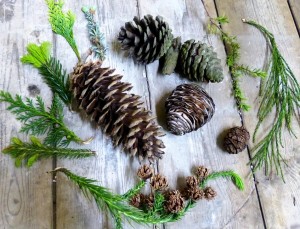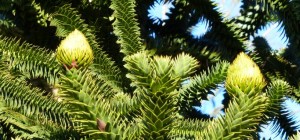Monday 18th May 2015 was the 3rd International Fascination of Plants Day established to provide a global focus for celebrating the wonders of the plant world.
At the University of Reading Dr M together with palaeoecologist Dr Macarena Cardenas celebrated FoPD with colleagues and students from the School of Biological Sciences and School of Archaeology, Geography and Environmental Science as well as a special guest Professor John Warren (previously seen at drmgoeswild here) who travelled all the way from the University of Aberystwyth to be with us for this special day, but more of that later.
- Dr Macarena Cardenas (emerging from the primeval forest!)
- Dr M (have you got the cones? No it’s just the way I walk!)
- Professor John Warren (have leaf will travel!)
The botanical spotlight was on the fascination of a large group of plants called the Gymnosperms and more specifically on the largest group of Gymnosperms, the Conifers and even more specifically on the conifer genus Araucaria which is better known as the Monkey Puzzle tree!
Gymnosperms are fascinating plants which produce seeds but which don’t flower. In fact the word Gymnosperm means ‘naked seeds’ (in Greek) and refers to seeds not enclosed in a flower but bare and naked and attached to the mother plant, you can find them attached to scales (modified leaves) in the cones!
The Conifers are the largest group of Gymnosperms and have their seeds in cones (there are no flowers). There are eight families, 68 genera and 630 species including familiar plants like Pine, Fir, Spruce and Cedar as well as Monkey Puzzles.
Araucaria – The scientific name for the Monkey Puzzle – is a fascinating plant familiar to us in gardens and parks in Britain. But where does it come from and what is its story?
Well, there are actually nineteen different species of Araucaria growing in New Caledonia, Norfolk Island, Australia, New Guinea, Argentina, Chile and Brazil. They are big trees growing to 30-80 m tall with whorls of horizontal branches and leathery or needle-like leaves. The female cones are globose and up to 25cm in diameter and bear large and delicious pine nuts which are much loved by birds, rodents as well as humans!
Araucaria has been sacred to the Jê and Mapuche people of Brazil, Chile and Argentina where their seeds were traditionally harvested for food. The current Araucaria populations are relicts of previously vast Jurassic forests (200 million years ago).
Unfortunately Araucaria populations today are threatened by changes in land-use and climate and all are listed as of global conservation concern. Huge conservation efforts have been taking place to protect and restore natural populations of this living fossil.
Several local schools joined us to enjoy bespoke botanical activities:
- Fossil and microscopic world – take a look into the past and handle specimens that are millions of year old and dating from when the dinosaurs roamed the Earth! You will also have the chance to look into the microscope world of plant cells just 50 microns across (100 times smaller than your little finger!).
- Living Monkey Puzzle walk and talk – take a short walk to a real live specimen of this fascinating plant that is almost 20m high (400 times your little finger!) and play our Fascinating Plant quiz and learn how it got its puzzling name and how it came to grow in England more than 7000 miles away from its native South America!
Monkey Puzzle puzzle 1 – Where does the name Monkey Puzzle come from?
Monkey Puzzle puzzle 2 – Monkey Puzzles have been grown in Britain for several centuries so how did it get from its native Chile in South America to Britain, some 7000 miles away?
Monkey Puzzle puzzle 3: How big are the Monkey Puzzle nuts, what do they look like and are they really edible and delicious?
These and other monkey puzzles were cracked by Dr Macarena Cardenas and our two nutty plant Professors Dr M and Professor John Warren from University of Aberystwyth who between them will officially un-puzzle you before your very eyes!
Doing the Conifer Walk: At 2.30 pm we celebrated the fascination of Gymnosperms with a botanical walk from the library across our prize-winning green campus to the beautiful Harris Garden. The walk was lead by Dr M and will take in a number of different specimen trees on the award-winning green campus of UoR. Learn about the features of cones and leaves which help ID different types of conifer.
Archibald’s Monkey Puzzle dream: At the end of the walk we met a beautiful Monkey Puzzle tree and a slightly less beautiful 18th century Scottish botanist – Archibald Menzies – and hear all about his botanical dream to feed Europe with the large, edible and delicious nuts of the Monkey Puzzle tree!
Did Archibald’s dream come true? Well, check out Professor John Warren’s feature on Monkey Puzzles at his Pick of the Crop blog here!
Meet the FoPD 2015 team:
Dr Macarena Cardenas is Post Doctoral Research Associate at University of Reading in charge of palaeoecological research for the project ‘Je Landscapes of southern Brazil: Ecology, History and Power in a transitional landscape during the Late Holocene’. Her interest cover Paleobotany, palaeoecology and ethnobotany.
Professor John Warren is Director of Learning and Teaching and Professor of Botany at the Institute of Biological, Environmental and Rural Studies at the University of Aberystwyth. Prof John Warren has an academic interest in the sex-life of plants and a recreational interest in all things edible. His latest book The Nature of Crops provides a fascinating story of how we came to eat the plants we do, order your copy here.
Dr M is Associate Professor of Field botany and Senior Botanist at RSK plc. Dr M teaches vegetation survey and assessment on the University of Reading MSc Plant Diversity and MSc SISS. He is creater and curator of the botanical website www.drmgeswild.com recently hailed by one of his students as “the best supplementary aid to learning I have ever had at University”.






